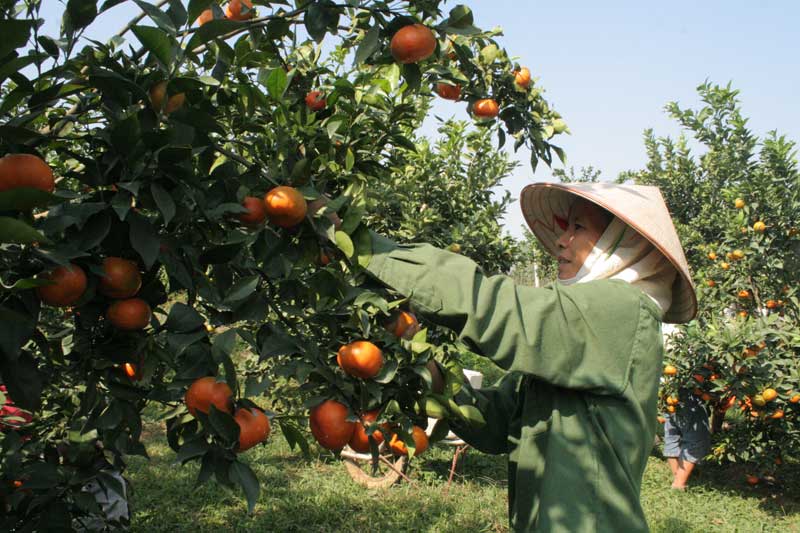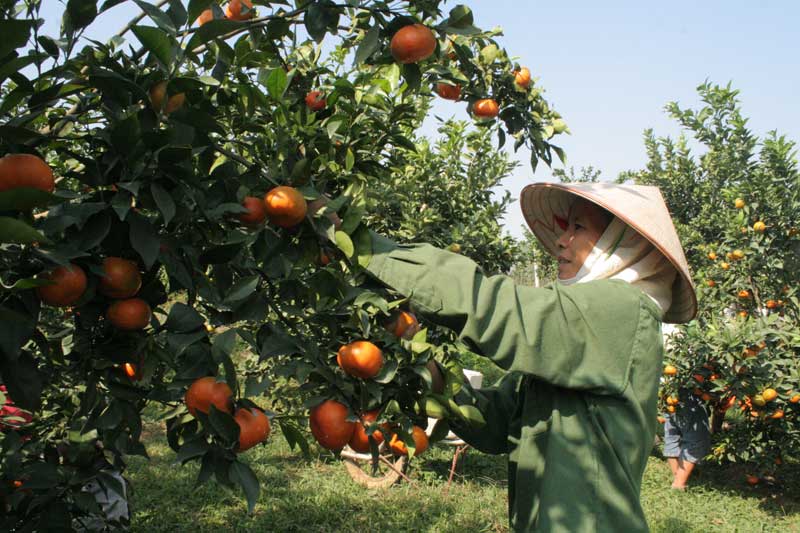
(HBO) – The fruit tree farming development t is bringing about positive outcomes in many communes in Kim Boi district, the northern province of Hoa Binh.
Chairman of the My
Hoa communal People’s Committee Bui Xuan Hoan said since citrus trees began to
be planted in My Hoa fields in 2013, the commune has developed thanks to the
cultivation. From only several families planting orange trees at first, a
movement of reclaiming poor-performing land for citrus tree farming has spread
to almost all hamlets. Local farmers’ awareness and cultivation capacity has
been improved.
He added last year, orange productivity
approximated 20 tonnes per hectare. Canh oranges were sold at 20,000 VND per kg
while V2 (also called
Valencia)
oranges were sold at 32,000 VND per kg, generating some 250 million VND (11,000
USD) per hectare in income, much higher than the income from sugarcane farming.
Many households have earned hundreds of millions of VND from selling oranges.
My Hoa
commune (Kim Boi district) has expanded the area under orange trees to
175 hectares,
45 hectares of which
have borne fruit for sale.
The orange farming area in My Hoa commune has
reached
175 hectares,
45 hectaresof which have borne fruit for sale, with good growth. The productivity and
output are forecast to rise sharply and will become a big source of revenue if
prices are stable. The commune does not worry about the sale of the fruit
because farmers formed partnerships and their partners will be in charge of
this step. In the previous crop, traders also highly valued the quality of
local oranges.
Not only in My Hoa but also in many communes
like Kim Tien, Nam Thuong,
Sao
Bay and Tu Son, orange
and grapefruit trees are growing well. This year’s crop promises higher
productivity and output, bringing about new chances to form concentrated
production areas in Kim Boi district. Aside from citrus fruits, longan trees
are also developing and proving highly effective in some communes, especially
Thuong Bi and Son Thuy. In particular, Son Thuy is entering the longan harvest
season. Fifty-eight of the
110
hectares of longan trees in the commune have borne
fruits for harvest, producing an estimated output of some 700 tonnes this crop.
With current prices, longan can generate over 17 billion VND in income for
local farmers.
With the set orientation and support policies,
the fruit tree area in Kim Boi has expanded rapidly. In 2011, the district had
about
100 hectaresof fruit trees, including
45.5
hectares of citrus trees. The total area now covers
1,128 hectares,
including
390 hectaresof orange trees,
415
hectares of grapefruit trees and
77 hectares of lime
trees, mostly in
Tu Son,
Nam Thuong,
Sao
Bay,
Kim Boi and My Hoa communes. Meanwhile, the
231 hectares of longan
trees concentrate in Son Thuy and Thuong Bi communes. Some areas that produce
fruits for the first time also had encouraging outcomes. Farmers can gain
350-400 million VND per year from citrus trees.
Kim Boi district is reviewing its fruit tree
farming development plan and aims to have
1,200 hectares of
citrus trees in 20 communes in 2020. It targets about
675 hectares of orange
trees,
500 hectaresof grapefruit trees and
25
hectares of tangerine trees, and 70-80 percent of the
commercial area under sale contracts. To that end, local communes are making
fruit tree development plans which will focus on intensive cultivation,
high-quality seedlings, science-technology application, safe production
process, and production in value chains, thus forming sustainable production
areas./.
According to data from the Hoa Binh Provincial Party Committee, the industrial production index for the first six months of 2025 is estimated to have increased by 20% compared to the same period last year. This marks the highest year-on-year growth rate for this period since 2020.
In the first six months of 2025, Hoa Binh province’s export turnover was estimated at 1.145 billion USD, marking an 18.11% increase compared to the same period in 2024. Import turnover was estimated at $ 804 million, a 17.15% increase, which helped the province maintain a positive trade balance.
The lives of the ethnic minority farmers in Tan Lac district have gradually improved thanks to the new directions in agricultural production. This is a testament to the collective strength fostered through the professional associations and groups implemented by various levels of the district’s Farmers’ Union.
With the motto the "product quality comes first,” after nearly one year of establishment and operation, Muong village’s Clean Food Agricultural and Commercial Cooperative, located in Cau Hamlet, Hung Son Commune (Kim Boi district), has launched reputable, high-quality agricultural products to the market that are well-received by consumers. The products such as Muong village’s pork sausage, salt-cured chicken, and salt-cured pork hocks have gradually carved out a place in the market and they are on the path to obtaining the OCOP certification.
In the past, the phrase "bumper harvest, rock-bottom prices" was a familiar refrain for Vietnamese farmers engaged in fragmented, small-scale agriculture. But today, a new spirit is emerging across rural areas of Hoa Binh province - one of collaboration, organisation, and collective economic models that provide a stable foundation for production.
Maintaining growing area codes and packing facility codes in accordance with regulations is a mandatory requirement for agricultural products to be eligible for export. Recently, the Department of Agriculture and Environment of Hoa Binh province has intensified technical supervision of designated farming areas and packing facilities to safeguard the "green passport" that enables its products to access international markets.



